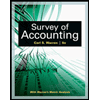
EXERCISE 12A-6 Value-Based Pricing; Absorption Costing Approach to Cost-Plus Pricing LO12-8, LO12-10
Valmont Company has developed a new industrial piece of equipment called the XP-200. The company is considering two methods of establishing a selling price for the XP-200-absorption cost-plus pricing and value-based pricing.
Valmont’s cost accounting system reports an absorption unit product cost for XP-200 of $8,400. Its markup percentage on absorption cost is 85%. The company's marketing managers have expressed concerns about the use of absorption cost-plus pricing because it seems to overlook the fact that the XP-200 offers superior performance relative to the comparable piece of equipment sold by Valmont's primary competitor. More specifically the XP-200 can be used for 20,000 hours before replacement. It only requires $1,000 of preventive maintenance during its useful life and it consumes $120 of electricity’ per 1,000 hours used.
These figures compare favorably to the competing piece of equipment that sells for $15,000: needs to be replaced after 10,000 hours of use, requires $2,000 of preventive maintenance during its useful life and comes $140 of electricity per 1,000 hours used.
Required:
- If Valmont uses absorption cost-plus pricing; what price will it establish for the XP-200?
- What is XP-200's economic value to the customer (EVC) over its 20:000-hour life?
- If Valmont uses value-based pricing, what range of possible prices should it consider when setting a price for the XP-200?
- What advice would you give Valmont's managers when choosing between absorption cost-plus pricing and value-based pricing?
Trending nowThis is a popular solution!

Chapter 13 Solutions
Managerial Accounting
- Morrison Industries manufactures wood polish. The standard direct materials quantity is 0.60 pounds per bottle at a cost of $2.50 per pound. The actual usage for the production of 40,000 bottles was 0.65 pounds per bottle at an actual cost of $2.45 per pound. Calculate the direct materials price variance and the direct materials quantity variance.arrow_forwardWhat was the direct materials price variance?arrow_forwardWhat is the total direct materials cost variance?arrow_forward
 Managerial AccountingAccountingISBN:9781337912020Author:Carl Warren, Ph.d. Cma William B. TaylerPublisher:South-Western College Pub
Managerial AccountingAccountingISBN:9781337912020Author:Carl Warren, Ph.d. Cma William B. TaylerPublisher:South-Western College Pub Survey of Accounting (Accounting I)AccountingISBN:9781305961883Author:Carl WarrenPublisher:Cengage Learning
Survey of Accounting (Accounting I)AccountingISBN:9781305961883Author:Carl WarrenPublisher:Cengage Learning

